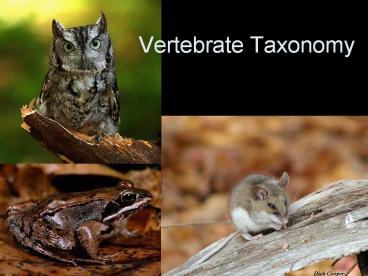Vertebrate Taxonomy PowerPoint PPT Presentation
1 / 32
Title: Vertebrate Taxonomy
1
Vertebrate Taxonomy
2
Keeping track of species
- Taxonomy describing and naming an organism
- gt1 million species named, up to 15 million more
- Taxonomy is not new cultures have been naming
plants and animals around them for 1000s of years - Its practical to have names
3
Binomial Nomenclature
- Standard system for naming things
- Linnaeus described and named gt 6,000 animals and
gt4,000 plants using Latin - Scientific name does not replace, but instead
further defines common name
4
- Watch out--there is a large, furry, four-legged
omnivore with long claws, a big mouth set in a
short, stout muzzle, attached to a round head
containing small eyes and short triangular ears
behind that rock! - OR
- Watch outtheres a bear behind that rock!
5
- Q. What is the largest wild felid (cat) in the
United States? - Mountain Lion
- Cougar
- Panther
- Painter
- Puma
- Catamount
6
- Puma concolor
7
Early naming of species
- 1st word was a noun Genus
- 2nd word was an adjective Specific epithet
- Genus specific epithet scientific name of a
species
8
- Procyon lotor
- Pro early
- Cyon dog
- Lotor swimming
- Tamias minimus
- Tamias animal who caches food
- Minimus smallest
9
- Peromyscus leucopus
- Pera small
- Mys mouse
- Leuco white
- Pus foot
- Canis latrans
- Canis dog
- Latrans barking
10
- May tell you where it was first discovered
- Didelphis virginiana 2 wombs from Virginia
- Sylvilagus floridanus wood-hare of Florida
- Or who discovered it
- Lepus townsendii hare discovered by Townsend
11
Taxonomic goals
- Place organisms into logical categories
- system must be capable of being used for
information retrieval, so anyone can properly
identify any organism - Place organisms into categories that show
ancestor-descendant relationships
12
Taxonomic hierarchy
- Kingdom (Animalia)
- Phylum (Chordata)
- Class (Mammalia)
- Order (Rodentia)
- Family (Castoridae)
- Genus (Castor)
- Specific epithet (species)
(canadensis) - Scientific name Castor canadensis
13
(No Transcript)
14
Phylum Chordata
- Several classes of fish
- Jawless fishes
- Sharks and rays
- Bony fish
- Class Amphibia (frogs, toads, salamanders)
- Class Testudines (turtles, tortoises)
- Class Lepidosauromorpha (snakes, lizards)
- Class Crocodilia (alligators, crocodiles)
- Class Aves (birds)
- Class Mammalia (mammals)
15
Class Amphibia
- Two stage life cycle
- Aquatic larvae
- Terrestrial adult
- Respiratory structures
- Gills (larvae)
- Lungs (adult)
- Skin
- Mucous and poison skin glands
- Three-chambered heart
- Ectothermic
- Egg-layers
- Must lay eggs in or near water
- Major groups
- Gymnophiona
- Caecilians
- Caudata
- Salamanders
- Anura
- Frogs and toads
16
Reptiles
- Shelled amniotic egg
- Skin hard and brittle
- Many have bony plates under scales
- Three-chambered heart
- Ectothermic
- Major groups
- Turtles
- Crocodilians
- Tuatara
- Lizards
- Snakes
17
Herp Traps
- Pitfall traps
- Useful for catching terrestrial arthropods and
small mammals - Usually include drift fence to increase capture
rate
18
Herpetology Module
- Dr. Sunny Boyd
- Lectures on ecology and phylogeny of herps
- Field exercises
- Collection of herps from UNDERC lakes and vernal
ponds - Study of mating calls of frogs
- Study of tadpole abundance and diversity
19
Class Aves
- Many orders of birds
- Columbiformes doves and pigeons
- Falconiformes diurnal birds of prey
- Apodiformes hummingbirds
- Gruiformes cranes and rails
- Piciformes woodpeckers
- Strigiformes owls
- Anseriformes ducks and geese
- Galliformes chickens and turkeys
- Passeriformes perching birds
20
Class Mammalia
- Many orders of mammals
- Rodentia rodents
- Chiroptera bats
- Soricomorpha shrews and moles
- Carnivora cats, dogs, bears, weasels, raccoons
- Lagomorpha rabbits
- Artiodactyla ungulates
- Primates
- Didelphimorphia American marsupials
21
Mist Nets
22
Mammal Traps
Tomahawk traps
Sherman traps
Leg-hold traps
23
Noninvasive Techniques
Scent Stations
Bat Detectors
Trailmaster Cameras
Observation
Tracking Stations
24
Ornithology/Mammalogy Module
- Lectures on ecology and conservation of birds and
mammals - Field exercises
- Exciting morning exercies (birding, mammal
trapping) - Fun night exercises (howl surveys, owling)
- Radio telemetry
25
1
26
2
27
3
28
4
29
5
30
6
31
7
32
8

